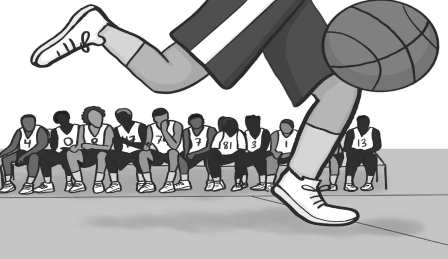SPORTS: Cut or no-cut? Students discuss the differences between cut and no-cut sports

Basketball is one of many cut sports on campus requiring students to undergo a tryout process.
For high school athletics, some sports are cut sports while others are no-cut. Although some SCHS students believe that no-cut sports allow more opportunities for students, they also acknowledge the differences in the environment between cut and no-cut sports.
For some sports, the no-cut rule was implemented to increase the number of participants on the team. Senior Kathleen Nguyen has played water polo for three years, and she believes water polo is a no cut sport due to its lack of popularity.
“Not a lot of people have heard of the sport. Not a lot of people want to play the sport,” Nguyen said. “So it’s really hard to get people to play. It’s really hard to find people and get them to stay.”
Senior Dino Beslagic believes it does not matter if people automatically make the team as long as they put in the effort. Beslagic was the kicker for the Bruins football team, which is a no-cut sport.
“You’re on the team, but you still have to earn your starting spot,” Beslagic said. “As long as they give it 100%, they deserve to be there.”
On the other hand, Beslagic also plays soccer during winter, which is a cut sport. Beslagic said he gets a different feeling when he makes a cut team compared to a no-cut team.
“You feel relieved. You worked hard, made the team, and then you also feel nervous at the same time because now you gotta work your way to a starting spot,” Beslagic said.
Sophomore Kelly Winter, who played field hockey and is currently playing soccer, believes there is an apparent difference between cut and no-cut sports, specifically during practices.
“In practices with field hockey, people were just there to hang out, which is fine because it’s a no-cut sport,” Winter said. “It’s not like soccer where you work hard to practice and get better.”
Winter also believes there is a difference in terms of being prepared when it’s time for the team’s next game.
“Our practices are a little more lax for field hockey, so when we get into the games, we are not as prepared as we probably will be for soccer when those games come,” Winter said.
Beslagic thinks a no-cut system benefits the team and its players and creates the motivation and drive to do better.
“It brings more variety, more competition. You have to work even harder now because in football, there are at least 55 people on the team. So you gotta work harder to be better than others,” Belsagic said.
Winter, on the other hand, said she believes playing a no-cut sport will not have any benefits, especially if the coach wants everyone involved.
“If the coach has the idea that everyone is going to get playing time, you’re not going to do as good as you might have otherwise because there’s disparity in skill level,” Winter said.
Winter, however, does think no-cut sports are a great opportunity for students who want to try out new things.
“I think there being no cut is helpful for getting people out there because now they’re not going to be scared to come try a new sport they’ve never played before because they could get cut, and that’s a bad feeling,” Winter said. “It helps get people on the field.”

